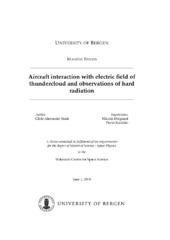| dc.description.abstract | The purpose of this thesis is to study the relationship between the different phases of lightning flashes and the production of high-energy emissions, as well as highenergy emissions observed from thunderclouds. The data consists of local electric field-, current- and energy measurements on board an aircraft. The lightning attachment points on the aircraft, were identified by the local electric field signatures of the positive and negative leader initiations. Showing a preference of attachment points based on aircraft model and/or flight altitude. Four distinct radiation producing events were identified by the electric fields and x-ray counts measured during the flights. Single photons in association with the stepping of negative leaders, with photon energies close to 100 keV. A correlation between the changes in local electric field, current and the energy of the observed photons were investigated, but were not found. Bursts of photons in association with recoils were observed. Recoils are microsecond fast changes in the local electric field, observed during the return strokes, dart leaders and recoil streamers of a lightning flash. The energies of the observed photon bursts are similar to that of the single photons observed during negative leader steps. Minute long gamma-ray glows from the data set has previously been reported. The findings were used as a basis to search for more gamma-ray glows in the dataset, and a total of 7 new low intensity gamma-ray glow candidates were found. A statistical analysis of the count rates were done for all observed gamma-ray glows to compare the events. Millisecond long x-ray count rate enhancements were observed on 14.01.2016. The lightning flashes were analysed by examining x-ray count rates and local electric fields. The energy spectrum of some of the observed flashes revealed an enhancement at 511 keV, which is the signature energy for positron annihilation. Two previously observed events were compared to two new findings, showing a very good correlation. | en_US |
